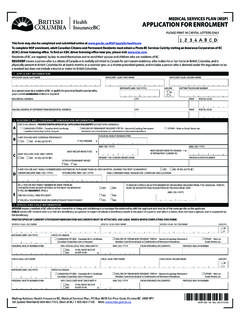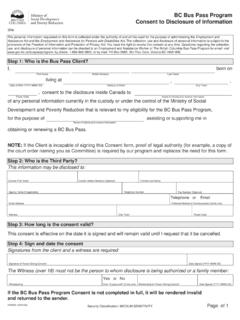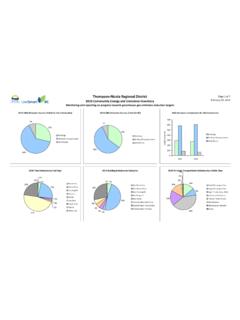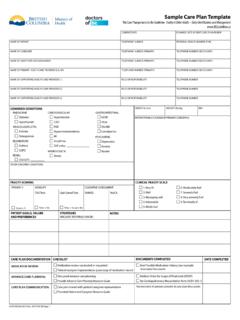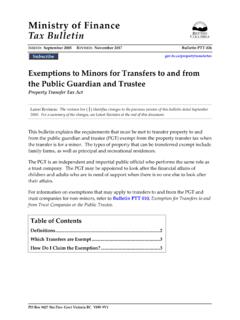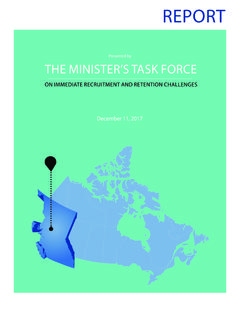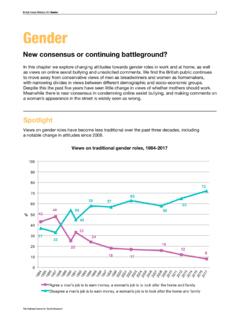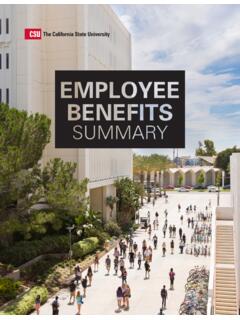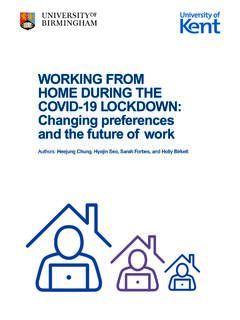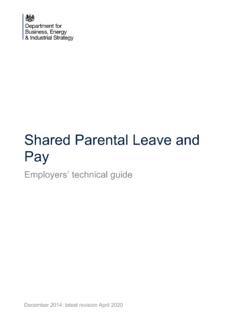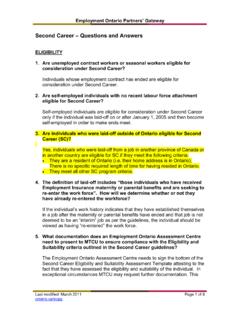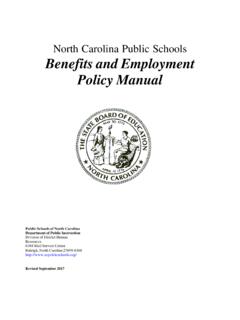Transcription of Working in BC Poster - British Columbia
1 UpdatedFebruary 2022 Working in British ColumbiaMINIMUM WAGEE mployees must be paid at least minimum wage regardless of: How they are paid hourly, salary, commission or other incentive basis Their status full time, part-time, temporary or permanentThe minimum wage in as of June 1, 2022 is $ per employee groups like live-in home support workers, resident caretakers and certain farm workers have different wage rates. Check the Employment Standards Regulation for more AND GRATUITIESE mployers can collect tips and distribute them to all employees who shared in earning them. Employers cannot withhold tips or force employees to give their tips to them unless they re required to do so by law ( a court order to garnish wages).
2 Employers can only take a share of tips if they regularly do the same or similar work as the employees who share DAILY PAYAn employee who reports for work must be paid for at least 2 hours, even if they work less than 2 hours. If the employee is scheduled for more than 8 hours, they must be paid for at least 4 work stops for a reason beyond the employer s control, the employee must be paid their minimum daily pay or the actual time worked, whichever is employee is only paid for time actually worked if: They are unfit to work They do not meet WorkSafeBC health and safety regulationsMEAL BREAKSA 30-minute unpaid meal break must be provided when an employee works more than 5 hours in a row.
3 Employers are not required to provide coffee employee must be paid for the meal break if they re required to work (or be available to work) during their meal AND PAYROLL RECORDSE mployees must be paid at least twice per month. Pay periods cannot be longer than 16 wages earned, including overtime and statutory holiday pay, must be paid within 8 days after the end of the pay must provide a pay stub (wage statement) every payday. It should include: The employer s name and address The hours worked by the employee The employee s wage rate and how the wages were calculated ( hourly, salary, flat orpiece rate, commission, or other incentive basis) The employee s overtime rates The hours worked at overtime rates Any money, allowance or other payment the employee is entitled to ( vacation pay orstatutory holiday pay)
4 The employee s gross and net wages Any amounts withdrawn from the employee s time bank and how much time remains The employee s wage rate and how the wages were calculated The amount and purpose of each deductionEmployers must keep payroll records for each employee for 4 employee must be paid final wages if their job ends: Within 48 hours, if they are terminated or laid off Within 6 days, if they quitFinal wages includes everything the employer owes the employee for example, regular wages, overtime, statutory holiday pay, compensation for length of service, and vacation are paid time-and-a-half for any time worked over 8 hours in a day, up to 12 hours.
5 Employees are paid double time for any time worked over 12 hours in a are paid time-and-a-half for any time worked over 40 hours in a week, counting only the first 8 hours worked each employee can make a written request to bank their overtime hours instead of being paid for them during the pay period when they re earned. Hours need to be banked based on the overtime rate they were earned at. Later on, the employee can ask for: Part or all of the wages in the time bank to be paid out Time off with pay for a period agreed upon by the employer and employeeAVERAGING AGREEMENTSAn employer and an employee can agree to average work hours over 1, 2, 3, or 4 agreements must be: Agreed to before they start In writing Specify a start and end dateEmployees are paid overtime if they work more hours than their regular schedule.
6 They are paid time-and-a-half when they work more than 8 hours in a day if the extrahours are more than their regular schedule or They are paid time-and-a-half for hours worked over an average of 40 hours in a weekduring the agreed averaging period ( 80 hours averaged over 2 weeks)UNIFORMS AND SPECIAL CLOTHINGIf employers require a uniform or special clothing, they must provide them to employees at no cost. They must also pay to clean and maintain these items or agree to reimburse employees for doing it. They cannot charge employees a deposit for clothing is any item that creates a specific image, including items: Chosen by the employer Purchased from a specific store, including garments the business is selling In a specific brand or style With a company logo or unique company coloursEmployers do not have to pay for an employee to meet a general dress code such as business casual, no jeans, no cut-offs, or a white shirt with dark must purchase their own.
7 Clothing needed for protection against the elements General purpose work gloves Appropriate footwear including safety footwear Safety headgearThese items are only considered special clothing or a uniform if it identifies employees with the employer ( a company logo).TEMPORARY FOREIGN WORKERST emporary foreign workers are covered by the Employment Standards Act and are entitled to all of its protections. In addition, many foreign workers have additional protections under the Temporary Foreign Worker Protection employer is required by law to make deductions from employee wages, for example: Income tax Employment Insurance premiums (EI) Canada Pension Plan contributions (CPP) A court order to garnish wagesIf an employee agrees in writing, other wage deductions can also include: Medical premiums Repayment of payroll advances or purchases made from an employer Accidental overpaymentsIt s illegal to make employees pay for business expenses, even if they agree to it.
8 This includes deducting expenses because company property was stolen or damaged, or a customer left without HOLIDAYST here are 10 statutory holidays in British Columbia : New Year s Day Victoria Day Labour Day Christmas Day Family Day Canada Day Thanksgiving Day Good Friday B. C. Day Remembrance DayEaster Sunday, Easter Monday, National Day for Truth and Reconciliation and Boxing Day are not statutory holidays in get paid for statutory holidays if they re qualified. To qualify for statutory holiday pay, an employee must: Have been employed for at least 30 calendar days and Have worked on at least 15 of the 30 days before the statutory holiday (employees whoworked under an averaging agreement do not have to work 15 days)Statutory holiday pay equals an average day s who work on a statutory holiday must be paid an average day s pay plus time-and-a-half for hours they work.
9 They re paid double time for hours worked over12 and employees may agree in writing to substitute another day for astatutory VACATIONA fter 1 year of employment, employees can take up to 2 weeks per year off for vacation. After Working for 5 consecutive years for the same employer, employees can take 3 weeks time must be taken within 12 months of earning it. That means employees earn vacation during their first year of employment and use it during the following time is taken in periods of 1 or more weeks. Employees can ask to take just 1 or 2 days off at a time it s up to an employer whether or not they want to approve this type of request.
10 Employers cannot require employees to take vacation in periods of less than 1 week at a pay is at least 4% of an employee s total wages. Vacation pay increases to 6% after an employee has worked for the same employer for 5 consecutive pay is calculated on all wages earned from the first day an employee starts employment. It s considered part of an employee s total wages for the year. Vacation pay is not paid to employees who work for 5 calendar days or pay must be paid at least 7 days before an employee starts their annual vacation. If an employee and employer agree in writing, employees can take vacation pay on every pay employment ends, all outstanding vacation pay must be paid on an employee s final pay cheque even if they worked less than 1 FOR LENGTH OF SERVICEWhen employment ends, employers are required to give employees written Working notice or an equal amount of pay called compensation for length of service.
